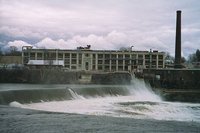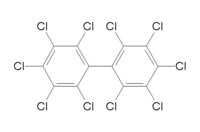PCBs
Polychlorinated Biphenyls (PCBs) are mixtures of human-made chemicals with similar chemical structures. PCBs can range from oily liquids to waxy solids. Due to their non-flammability, chemical stability, high boiling point and electrical insulating properties, PCBs were used in hundreds of industrial and commercial applications including electrical, heat transfer, and hydraulic equipment; as plasticizers in paints, plastics and rubber products; in pigments, dyes and carbonless copy paper and many other applications. More than 1.5 billion pounds of PCBs were manufactured in the United States prior to cessation of production in 1977.
Concern over the toxicity and persistence (chemical stability) in the environment of Polychlorinated Biphenyls (PCBs) led Congress in 1976 to enact Section 6(e) of the Toxic Substances Control Act (TSCA) that included among other things, prohibitions on the manufacture, processing, and distribution in commerce of PCBs. Thus, TSCA legislated true "cradle to grave" (i.e., from manufacture to disposal) management of PCBs in the United States.
Polychlorinated biphenyls (PCBs) are chemically related to organochlorine pesticides. Each PCB molecule consists of chlorine atoms attached to a double carbon-hydrogen ring (a "biphenyl" ring). There are actually 209 different PCB "congeners", which differ in the number and location of chlorine atoms. There are three categories of PCBs: 1) PCBs that are chlorinated in two or more ortho positions (ortho positions are closest to the single bond joining the two aromatic rings); 2) those that are chlorinated in only one ortho position (mono-ortho); and 3) PCBs lacking any ortho chlorination, known as non-ortho or co-planar PCBs. Early work on PCBs focused on PCB mixtures such as A1254, 1260 or 1248. Later work focused on individual PCB congeners, with the greatest emphasis on the co-planar PCBs. Many of the adverse effects of these co-planar PCBs are similar to the adverse effects of dioxins, and other dioxin-like chemicals. Most recently the focus is shifting back to PCB mixtures and to congeners other than the co-planars because, although the co-planar PCBs may be the most potent congeners, other congeners may have important toxic effects as well.
Like chlorinated pesticides, PCBs remain in the environment for long periods of time, have low water solubility, and accumulate in fat tissues. Unlike pesticides, PCBs were never purposefully released into the environment to kill plants or animals. Rather, these mixtures of chlorinated compounds were used in industry, mostly as lubricants and heat dissipators in electrical transformers and capacitors, entering the environment through careless behavior.
There are a broad range of health effects caused by PCB exposure. In birds and fish, PCBs are known to impact the immune system, reproductive system, nervous system, and endocrine system. They also cause a variety of adverse health effects in humans. Studies provide supportive evidence for potential carcinogenic and non-carcinogenic effects, and PCBs are considered probable carcinogens. The different health effects of PCBs may be interrelated, as alterations in one system may have significant implications for the other systems of the body.

The General Electric Co. discharged between 209,000 and 1.3 million PCBs into the river from two capacitor manufacturing plants located in Hudson Falls and Fort Edward. Since that time, the spread of PCBs throughout the river and its food chain has created an extensive toxic waste problem. About 200 miles of the river is designated as a Superfund site. In 1976, because of the concern over the bioaccumulation of PCBs in fish and other aquatic organisms and their subsequent consumption by people, the State of New York banned fishing in the Upper Hudson River and commercial fishing of striped bass, and several other species, in the Lower Hudson. In August 1995, the Upper Hudson was re-opened to fishing, but only on a catch and release basis.
Though required by Superfund laws (CERCLA) to clean up the PCBs, GE continually battled the U.S. Environmental Protection Agency (EPA) over the regulations, although an agreement was finally reached in 2005. Much of the PCBs in the lower Hudson originate from toxic "hot spots" upstream, then disperse downstream, causing continued contamination of the entire Hudson River. Cleanup is finally getting started, but in the past 30 years the PCB-contaminated sediments have spread out to cover a much more considerable stretch of the river than they did originally, making the effort both more extensive and expensive. Elevated PCB levels are found all around the New York/New Jersey Harbor, about 40% of which originates from local sources rather than the upper Hudson. The level of PCBs in white perch populations is strongly related to the percent of development in the local watershed; when the level of development of the watershed fills about 20% of the area, PCB levels in the fish begin to exceed the recommended levels safe for food consumption. This indicates that land-use (development) near the estuary has important effects on the PCB levels in white perch. Bluefish, being higher up on the food chain and eating mostly other fish, accumulate high levels of PCBs while living in the contaminated estuaries of the system.
PCBs have been banned in the US since 1976, but they continue to be redistributed and dispersed. More than 25 years after the prohibition, they are still accumulating in fish tissue to an extent that state agencies recommend that people eat no striped bass or blue crabs from the Newark Bay area, and no more than one meal a week from other areas in the New York Harbor estuary.
Other PCB-contaminated sites include the Housatonic River in Massachusetts which is undergoing remediation, and New Bedford Harbor, Massaschusetts. Some of the highest concentrations of PCBs measured in the country have been measured in wildlife from the Housatonic River or surrounding areas. New Bedfod Harbor is an 18,000-acre tidal estuary with sediments that are highly contaminated with PCBs and heavy metals. Manufacturers in the area used PCBs while producing electric devices from 1940 to the late 1970s, when PCBs were banned. These facilities discharged wastes with PCBs directly into the harbor and into the city's sewage system, which also led into the harbor. PCB levels in fish and lobsters at the site exceed the Food and Drug Administration's (FDA) limit for PCBs in edible seafood. There is an increased risk of cancer and other diseases for people who regularly eat seafood from the area.
Fish from several highly contaminated sites such as New Bedford Harbor, Newark Bay, New Jersey and the Hudson River have developed resistance to some of the biochemical changes caused by PCBs. These heritable changes are thought to provide some level of protection against toxicity caused by PCBs and similar chemicals.
Further Reading
| Disclaimer: This article is taken wholly from, or contains information that was originally published by, the Environmental Protection Agency. Topic editors and authors for the Encyclopedia of Earth may have edited its content or added new information. The use of information from the Environmental Protection Agency should not be construed as support for or endorsement by that organization for any new information added by EoE personnel, or for any editing of the original content. |
